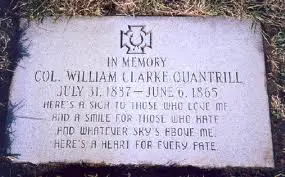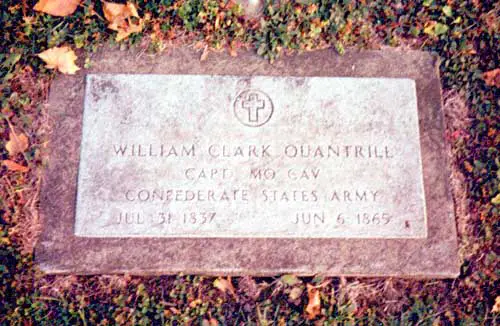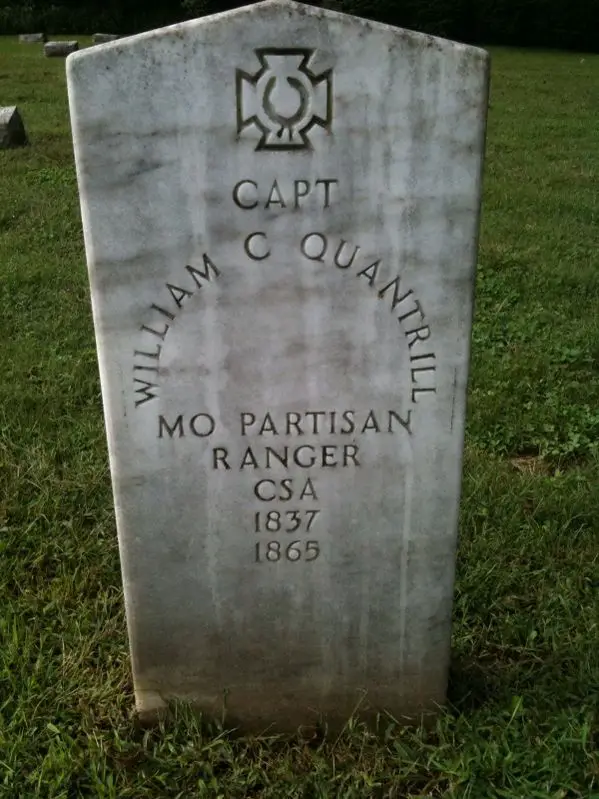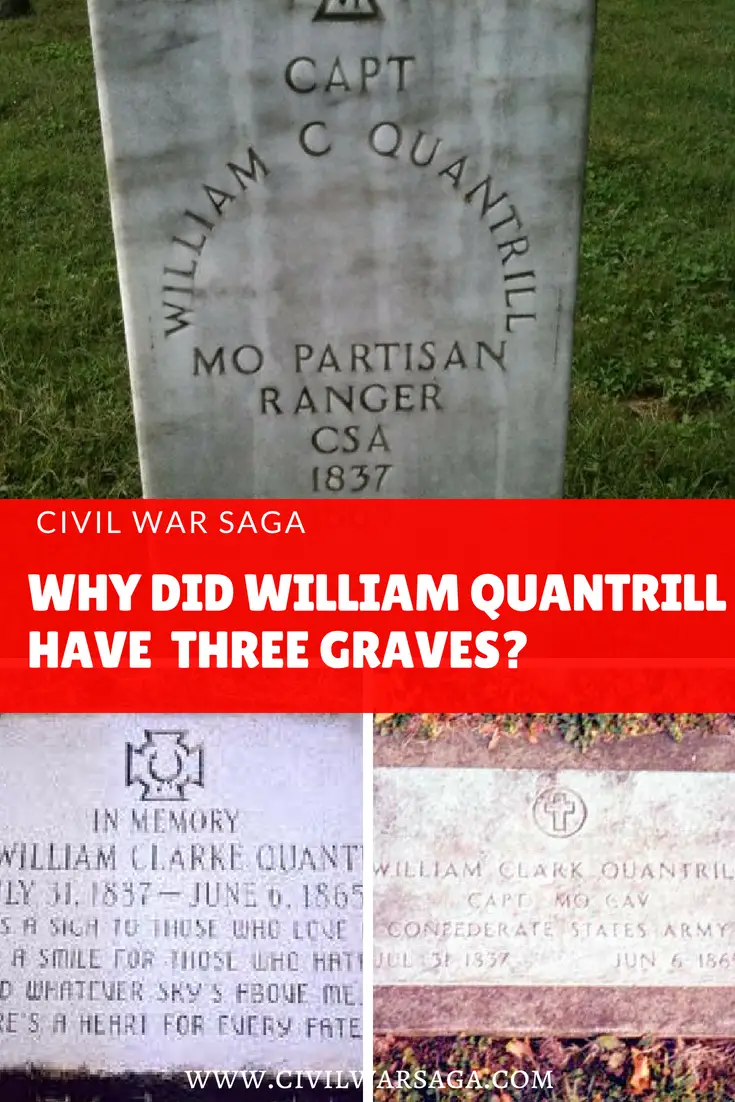William Quantrill was the leader of a violent group of Confederate guerrillas, known as Quantrill’s Raiders, whose members included brothers Frank and Jesse James.
After Quantrill was shot and paralyzed during a skirmish with Union soldiers in Louisville, Kentucky in May of 1865 and died a month later on June 6th, his body was buried in Louisville’s St Mary’s Catholic Cemetery.

William Quantrill’s grave in Louisville, Kentucky
Years later, in 1887, Quantrill’s mother and his childhood friend, William W. Scott, visited his grave with the intention to dig him up and bring his body to his hometown of Dover, Ohio.
After Scott started digging, he discovered Quantrill’s bones had mostly disintegrated and only a few large bones and his skull remained. His mother identified the remains from a chipped tooth he had since childhood.
Scott promised to transfer whatever bones he was able to salvage to Dover but never actually did it. Instead, he unsuccessfully attempted to sell the bones to collectors.
In 1889, a box that was believed to contain Quantrill’s bones was buried Dover’s Fourth Street Cemetery but its contents were never examined.

William Quantrill’s grave in Dover, Ohio
After Scott’s death in 1902, his son gave Quantrill’s skull to a boys club that later became a fraternity. The fraternity used the skull in its initiation rituals until 1942 when the fraternity disbanded.
Finally, in 1972, a fraternity alum donated the skull to to Dover Historical Society. Scott’s widow sold the remaining bones to a collector named William E. Connelley, who later became the secretary of the Kansas State Historical Society.
After a deal fell through to trade the bones and a lock of Quantrill’s hair for some weapons owned by Jesse James and Wild Bill Hickok, Connelley donated the remains to the historical society.
The organization later placed the bones on display before giving some of them away and keeping the rest in storage, according to the book “Ohio Oddities”:
“The bones eventually ended up in the hands of the Kansas State Historical Society. In 1992, they gave one of Quantrill’s arms and a shinbone to the Missouri Division of the Sons of Confederate Veterans, who buried them in the Confederate cemetery in Higginsville, Missouri. The skull went to the Dover Historical Society, which had it interred (in a fiberglass child’s coffin) in the Fourth Street Cemetery. Before it went back in the ground, though, a cast-clay replica of Quantrill’s head was made from the skull. This was displayed at the historical society for a while, but during the hot days of summer, water would bead on the surface, making it look like the head was alive and sweating. This disconcerted some of the visitors so much that the head was removed to a refrigerator. Now it is only shown on request.”
The decision to rebury the bones was met with some controversy in both Missouri and Ohio, mostly from people who objected to having a historical figure with such a violent reputation buried in their town, according to the book “The Devil Knows How to Ride: The Story of William Clarke Quantrill”:
“Some people criticized the idea of burying an ‘evil’ man in the [Higginsville Confederate] cemetery, and in his homily, Father Behan, a self-described pacifist and an Irish immigrant with a profound interest in American history, evoked the recent controversy over the celebration of the five-hundredth anniversary of Columbus’s voyage and warned against judging historical figures outside the context of their times and retroactively applying ‘our understanding of morality and ethics, of rightness and wrongness, back into the country.”
There was also controversy among Quantrill’s fans and descendants over burying his remains in separate graves.
According to an article in the New York Times, Robert L. Hawkins III, who delivered the eulogy at Quantrill’s burial in Higginsville, said he tried to reunite all of Quantrill’s remains for a single burial in Higginsville but failed.

William Quantrill’s Grave in Higginsville MO
Hawkins said he wanted to keep the bones together to not only provide a proper burial for them but also to get them out of the hands of Northerners in Ohio who he felt looked down on Quantrill:
“We do not wish him buried where people are ashamed of him, where no one remembers or cares to recall the brutality of a partisan warfare that created men like Captain Quantrill and those who rode with him. He belongs here, here with those who were truly his people.”
On October 24, 1992, over 300 people attended the burial of Quantrill’s bones at the Old Confederate Veteran’s Home Cemetery in Higginsville, Missouri during which Quantrill’s remains were wrapped in plastic, placed inside a red-plastic beverage cooler and laid to rest inside a replica 19th century oak coffin draped with a Confederate flag.
The cooler was glued shut and the coffin lid was nailed down and buried under a layer of concrete to protect it from grave robbers.
Six days later on October 30, twenty-two people attended the burial of Quantrill’s skull in the Quantrill family plot in the Fourth Street Cemetery in Dover, Ohio, which was buried in a shallow three-foot grave above the remains supposedly buried there in 1889.
Sources:
“Ohio Oddities 2nd Edition: A Guide to the Curious Attractions of the Buckeye State;” Neil Zurcher; 2008
“The Devil Knows How to Ride: The True Story of William Clark Quantrill and His Confederate Raiders”; Edward E. Leslie; 2009
New York Times; “Guerrilla’s Bones Get a Confederate Soldier’s Funeral”; William Robbins; October 25 1992: http://www.nytimes.com/1992/10/25/us/guerrilla-s-bones-get-a-confederate-soldier-s-funeral.html
Roadside America: The Replica Head of Confederate Raider Quantrill: http://www.roadsideamerica.com/story/10054
PBS: William Clarke Quantrill: http://www.pbs.org/weta/thewest/people/i_r/quantrill.htm
History.com: William Quantrill Killed by Union Soldiers: http://www.history.com/this-day-in-history/william-quantrill-killed-by-union-soldiers


Is there any particular reason or information regarding why two of the headstones(at Higginsville & Louisville)are engraved with the Malta style cross?
Maltese cross represents the Confederate Cross of Honor and is on all official Confederate headstones and Grave Markers.
My mothers maiden name is Quantrill, the family is from London, I do believe that William Clarke Quantrill is related to my mothers forefathers…I wonder if it is possible to confirm this?
Nigel mahomet
You might read some of William Clarke Quantrill’s ancestry in William Elsey Connelley’s book Quantrill and the Border War. I believe the genealogy at least goes back to Quantrill’s grandfather.
I live about a mile from where Quantrill received his death wound. I have researched his last encounter for more than half a century. I have a .36 caliber Navy revolver found within 10 feet of where John Langford shot him, I was there when metal detection experts found a dime and two pennies very close to where Quantrill was shot, I have a previously unpublished photo of Quantrill, a spent bullet from the fight, a lock of Quantrill’s hair from the Langford family and more. I located Quantrill’s blood-stained battle sash and talked the owner into donating it to a museum. Everything I have will be donated to a local museum, if we ever get one. But I will sell the revolver if there is enough money to send at least one of my grand children to college.
I think I’m related to William Clark Quantrill. Is there still a grave in Louisville, Kentucky? I would like to place the Confederate and USA flag at his gravesite in Louisville, Ky.
There is one in Louisville, last time I was there, Im In Ky, and I’m damn sure not ashamed of him.
I attended the internment of Quantrill’s skull in Dover, Oh in 1992….
Well. I’m your man if your going to part with any of your undocumented un presidence unverified DNA items from metal detecting a battle site. He was not the only soldier there fighting.Be nice to post pics of what you have acquired. We can’t take history with us to our graves.So let history live on if your selling.
I’m going to Ohio this week and hope to visit his grave there and place a battle flag on it.